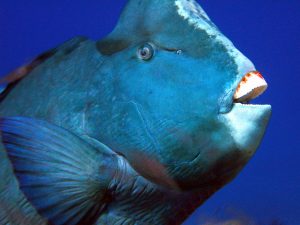Marine Life of Phuket – Parrot fish
It is almost guaranteed that when you dive on coral reef from Phuket, Thailand you will encounter the vibrant coloured Parrotfish.
Parrotfish are abundant and range in size from 30cm to 1.4m. How did this family of fish (Scaridae) derive the name Parrot? Just have a look at the dentition; numerous teeth are fused to form a beak, much like a parrot’s beak. The teeth aid feeding activity as the Parrotfish eats algae from coral and rocky substrates, often leaving teeth scars behind. Parrot fish are considered to be herbivores, but they are not necessarily vegetarians as the large Green hump head parrot fish is known to include coral polyps in it’s diet. The feeding activity of the parrotfish is important in the production and distribution of coral sands. If you watch Parrot fish excrete you will notice that it is fine white sand. This has been responsible for helping create small islands and beaches worldwide. It is estimated that a Parrotfish is capable of producing 90kg of sand per year!!! How is this possible? The beak takes the coral or rock and then it is pulverised by a set of grinding teeth located in front of the oesophagus. The digestion procedure gives sand as the end product. The Parrotfish eating habits are paramount in controlling algae growth resulting in a thriving reef. Another little fact about the Parrotfish is that their teeth continuously grow and by chomping on rock keeps the growth in check!!
Parrotfish are known to reproduce throughout the year, but more predominantly during the summer months. This family are generally sequential hermaphrodites starting their life as female then change to male. However, one exception to this is the Marbled Parrot fish, which is known not to change sex. Parrotfish are pelagic spawner’s. This means that the eggs are spawned in mid water and are buoyant, the eggs float freely eventually resting on the coral where they stay until they hatch. The Parrotfish larvae appear not to have any characteristic facial features or colouration for the first few days after hatching.
Juveniles have a different colour pattern to the adults and it is possible for juveniles of some tropical species are capable of changing colour temporarily to mimic other species. It is not unusual to see “flocks” of juveniles swimming en mass over a coral reef. Often they are dark in colour and occasionally an individual can be seen changing it’s pigmentation.
The Parrotfish are unique in that they are able to secrete a mucus cocoon from a gland near the mouth. This provides protection from nocturnal predators. Also, it can act as an early warning system allowing the fish to flee if the protective cocoon is disturbed. The Parrotfish is only able to produce this cocoon once during the night, so it is important when night diving not to disturb the sleeping Parrot fish.
The Parrotfish skin is covered in a mucus substance that is believed to have antioxidant properties that can help repair any damage that may occur to the skin. Also, the mucus has anti parasitic properties, repelling potential parasites.
There are approximately 80 identified species of Parrot fish, which are abundant in and around coral reefs worldwide. They are a close relative to the Wrasse family, but there are some distinctive features that help with identification. When trying to identify a parrotfish look for an elongated, blunt head. The body of the fish is deep and brightly coloured with defined large scales and finally look for the unique bird like beak.
If you would like to know more about the identification of species why not sign up for on a Aware – Fish Identification Specialty Course, which will enhance your knowledge and highlight the key things to look for.








Scubacat Community